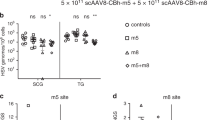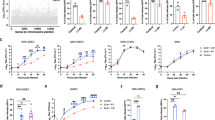Abstract
We previously reported that R7Δ447, a 2954-base-pair (bp) laboratory-generated Moloney murine sarcoma virus, induced subcutaneous tumors in about 14% of infected mice but did not induce brain lesions. We now report that R7Δ447K, a spontaneous mutant of R7Δ447, induced brain lesions as well as subcutaneous tumors in all injected mice. The genomes of the two viruses differ in a single base pair: the deduced Glu62 of the Mos residue of the R7Δ447 Gag-tMos protein is changed to Lys62. More R7Δ447 than R7Δ447K focus-forming units were detected in both NIH3T3 and mouse cerebral vascular endothelial (MCVE) cells. However, R7Δ447K transformed NIH3T3 and MCVE cells more acutely than did R7Δ447. A distinctive feature that distinguished the morphologic transformation of R7Δ447- and R7Δ447K-infected MCVE cells is the markedly prolonged spindle-shaped phase exhibited by R7Δ447-infected MCVE cells. In addition, R7Δ447K was more efficient in inducing the phosphorylation of ERK1/2 than R7Δ447 in both MCVE and NIH3T3 cells. Moreover morphologic transformation was inhibited, and levels of phosphorylated ERK1/2 were reduced when R7Δ447- or R7Δ447K-infected NIH3T3 or MCVE cells were grown in the presence of the MEK1/2-specific inhibitor PD98095. Thus, we have identified a key residue in the Gag-tMos protein that profoundly affects activation of the Mos/MEK/ERK pathway, virus and cell replication, morphologic transformation in vitro and pathogenicity in vivo.
This is a preview of subscription content, access via your institution
Access options
Subscribe to this journal
Receive 50 print issues and online access
$259.00 per year
only $5.18 per issue
Buy this article
- Purchase on Springer Link
- Instant access to full article PDF
Prices may be subject to local taxes which are calculated during checkout








Similar content being viewed by others
References
Alroy J, Goyal V and Skutelsky E. . 1987 Histochemistry 86: 603–607.
Berman LD and Allison AC. . 1969 Int. J. Cancer 4: 820–836.
Brow MA, Sen A and Sutcliffe JG. . 1984 J. Virol. 49: 579–582.
Chirigos MA, Scott D, Turner W and Perk K. . 1968 Int. J. Cancer 3: 223–227.
Cobb MH. . 1999 Prog. Biophys. Mol. Biol. 71: 479–500.
De Bondt HL, Rosenblatt J, Jancarik J, Jones HD, Morgan DO and Kim SH. . 1993 Nature 363: 595–602.
Dudley DT, Pang L, Decker SJ, Bridges AJ and Saltiel AR. . 1995 Proc. Natl. Acad. Sci. USA 92: 7686–7689.
Freeman RS, Meyer AN, Li J and Donoghue DJ. . 1992 J. Cell Biol. 116: 725–735.
Gazdar AF, Chopra HC and Sarma PS. . 1972 Int. J. Cancer 9: 219–233.
Gonzales-Scarano F, Nathanson N and Wong PKY. . 1995 The Retroviridae, Vol. 4. Levy JA. (ed.). Plenum Press: New York pp. 409–490.
Hanks SK, Quinn AM and Hunter T. . 1988 Science 241: 42–52.
Hannink M and Donoghue DJ. . 1985 Proc. Natl. Acad. Sci. USA 82: 7894–7898.
Hayashi Y, Tange T, Urano Y, Smadja-Joffe F, Le Bousse-Kerdiles MC and Jasmin C. . 1988 Pathol. Res. Pract. 183: 314–320.
Hu SH, Parker MW, Lel JY, Wallace MCJ, Benlan GM and Kemp BE. . 1994 Nature 369: 581–584.
Hubbard SR, Wei L, Ellis L and Hendrickson WA. . 1994 Nature 372: 746–754.
Le Bousse-Kerdiles MC, Smadja-Joffe F, Klein B, Caillou B and Jasmin C. . 1980 Eur. J. Cancer 16: 43–51.
Lim KY, Ryan EA, Wong PKY and Yuen PH. . 2000 J. Neurovirol. 6: 106–120.
Mansour SJ, Matten WT, Hermann AS, Candia JM, Rong S, Fukusawa K, Vande Woude GF and Ahn NG. . 1994 Science 265: 966–970.
Moloney JB. . 1966 Natl. Cancer Inst. Monogr. 22: 139–142.
Okazaki K and Sagata N. . 1995 Oncogene 10: 1149–1157.
Ostertag W, Vehmeyer K, Fagg B, Pragnell IB, Paetz W, Le Bousse MC, Smadja-Joffe F, Klein B, Jasmin C and Eisen H. . 1980 J. Virol. 33: 573–582.
Perk K and Moloney JB. . 1966 J. Natl. Cancer Inst. 37: 581–599.
Pham CD, Arlinghaus RB, Zheng CF, Guan KL and Singh B. . 1995 Oncogene 10: 1683–1688.
Propst F, Cork LC, Kovatch RM, Kasenally AB, Wallace R and Rosenberg MP. . 1992 J. Neuropathol. Exp. Neurol. 51: 499–505.
Propst F, Rosenberg MP, Cork LC, Kovatch RM Rauch S, Westphal H, Khillan J, Schulz NT, Neumann PE and Newmann PE. . 1990 Proc. Natl. Acad. Sci. USA 87: 9703–9707.
Puls A, Proikas-Cezanne T, Marquardt B, Propst F and Stabel S. . 1995 Oncogene 10: 623–630.
Ribacchi R and Giraldo G. . 1966 Lav. Ist. Anat. Istol. Patol. Perugia 26: 149–156.
Robertson SC and Donoghue DJ. . 1996 Mol. Cell. Biol. 16: 3472–3479.
Robinson MJ, Harkins PC, Zhang J, Baer R, Haycock JW, Cobb MH and Goldsmith EJ. . 1996 Biochemistry 35: 5641–5646.
Schmidt M, Oskarsson MK, Dunn JK, Blair DG, Hughes S, Propst F and Vande Woude GF. . 1988 Mol. Cell Biol. 8: 923–929.
Simons PJ and McCully DJ. . 1970 J. Natl. Cancer Inst. 44: 1289–1303.
Stacey A, Arbuthnott C, Kollek R, Coggins L and Ostertag W. . 1984 J. Virol. 50: 725–732.
Stanton MF, Law LW and Ting RC. . 1968 J. Natl. Cancer Inst. 40: 1113–1129.
Stoica G, Hoffman J and Yuen PH. . 1990 Am. J. Pathol. 136: 933–947.
Topol LZ and Blair DG. . 1995 Cell Growth Differ. 6: 1119–1127.
Van Beveren C, Galleshaw JA, Jonas V, Berns AJ, Doolittle RF, Donoghue DJ and Verma IM. . 1981 Nature 289: 258–262.
van der Hoorn FA and Firzlaff J. . 1984 Nucleic Acids Res. 12: 2147–2156.
Wong PKY. . 1990 Curr. Top. Microbiol. Immunol. 160: 29–60.
Wong PKY, Soong MM and Yuen PH. . 1981 Virology 109: 366–378.
Yew N, Oskarsson M, Daar I, Blair DG and Vande Wounde GF. . 1991 Mol. Cell Biol. 11: 604–610.
Yuen PH, Devroe E, Lim KY and Wong PKY. . 2000 J. NeuroVirol. 6: 106–120.
Yuen PH, Khang YH, Kumar A, Szurek PF and Maul EA. . 1991 Mol. Carcinog. 4: 72–80.
Yuen PH and Kwak YT. . 1997 Virology 236: 213–218.
Yuen PH and Kwak YT. . 1998 Am. J. Pathol. 152: 1509–1520.
Yuen PH, Malehorn D, Nau C, Soong MM and Wong PKY. . 1985 J. Virol. 54: 178–185.
Yuen PH and Szurek PF. . 1989 J. Virol. 63: 471–480.
Acknowledgements
We thank Sean Hensley and Dr Jianjun Shen of the Molecular Core at U.T.M.D. Anderson Cancer Center–Science Park for DNA sequencing and the Histology and Tissue Processing Core at U.T.M.D. Anderson Cancer Center–Science Park for histological processing. We also thank Judy Ing for assistance with the artwork, Dr Dennis Johnston for statistical analysis, and Kit Yeng Lim for technical assistance. We gratefully acknowledge the gift of MCVE cells isolated by Dr JR Welsh of Texas A&M University. Part of the sequencing and histological processing was supported by grant number ES07784 from the National Institute of Environmental Health Sciences.
Author information
Authors and Affiliations
Rights and permissions
About this article
Cite this article
Yuen, P., Ryan, E., Devroe, E. et al. A single Glu62-to-Lys62 mutation in the Mos residues of the R7Δ447Gag-tMos protein causes the mutant virus to induce brain lesions. Oncogene 20, 692–703 (2001). https://doi.org/10.1038/sj.onc.1204150
Received:
Revised:
Accepted:
Published:
Issue Date:
DOI: https://doi.org/10.1038/sj.onc.1204150
Keywords
This article is cited by
-
Eight paths of ERK1/2 signalling pathway regulating hepatocyte proliferation in rat liver regeneration
Journal of Genetics (2011)



